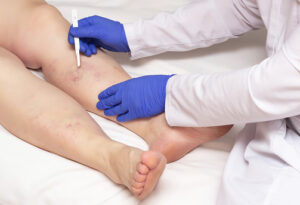Are varicose veins curable without surgery?

Did you know that varicose veins affect over one-third of adults in the United States at some point in their lives? Varicose veins are typically genetic, and while they’re usually harmless, they can be unsightly and uncomfortable. Worse, if they’re left untreated, they can lead to serious medical complications. If you have varicose veins, however, you might be reluctant to seek medical attention for them. Can you treat them at home without undergoing surgery?
It’s wise to see a doctor who can diagnose your varicose veins and offer treatment options. Once you’ve gotten a diagnosis, though, you can try the following tips if you’d rather hold off on medical intervention.
- Get more exercise. Varicose veins often go along with a sedentary lifestyle, and incorporating low-impact aerobic exercises into your life is a good way to help get your blood moving. Try walking, swimming, or biking, and if your job requires you to sit or stand for extended periods of time, take frequent breaks to walk around and stimulate the muscles in your legs.
- Try a change in diet. Eating a nutritious diet will benefit just about every system in your body, and your circulatory system is no exception. Cut back on sodium so that you won’t retain water, which can increase swelling in your legs. Fill your diet with nutrient-dense foods, especially those containing potassium, like potatoes, leafy vegetables, and fish like tuna and salmon. Colorful fruits and vegetables, like bell peppers, onions, spinach, broccoli, and citrus fruits can help promote circulation, and high-fiber foods like nuts and whole grains will improve your digestion.
- Elevate your legs. By keeping your legs propped up when you sit or sleep, you can encourage blood flow from the legs to the heart. Ideally, elevate your legs above your heart.
- Give the compression stocking solution a try. Compression stockings are made of tightly woven elastic that helps push blood back up to the heart. They come in over-the-counter and prescription varieties, and a 2018 study indicated that most patients who wore them saw a reduction in varicose vein symptoms. If you do decide to wear them, take them off when you sleep.
Sometimes, despite your best efforts, you won’t be able to get rid of varicose veins. Fortunately, there are many different treatment options available to help. While varicose veins used to be treated through a procedure called “stripping,” which involved anesthesia, a hospital stay, and a lengthy recovery period, today’s treatments are minimally invasive and require no hospitalization. For procedures like micro phlebectomy, endovenous laser treatment, radiofrequency ablation, and sclerotherapy, there’s virtually no downtime. These treatments are performed in your healthcare provider’s office, using only local anesthesia.
If you’re seeking the very best care for your vein and blood flow issues, trust the board-certified physicians at the Arizona Vein & Laser Institute. Using the most advanced technology, the vascular and cardiovascular surgeons at the Arizona Vein & Laser Institute provide care for all types of venous diseases. With over 40 years of experience, our team of experienced physicians can devise the right treatment plan to address your venous disease problems. For more information contact us through our website.
